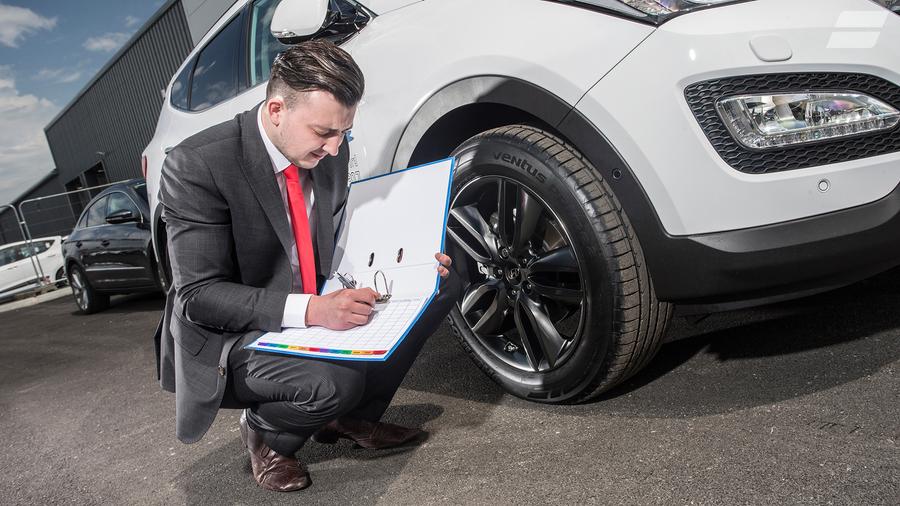Read this before buying a new car ( Check list )
Buying a new car is an exciting process which usually has you waiting with bated breath. Quite understandably, in the excitement of acquiring the keys to a new set of wheels, buyers tend to rush through the sign-off process. Most buyers tend to forget that before leaving the showroom with your new car, it is important to inspect the car thoroughly and ensure that the exteriors and interiors are devoid of any damage.
Often, a new car could get damaged while it is being transported from the manufacturer’s factory to the dealer’s stockyard. And it is not uncommon for some dealers to use new vehicles as ‘demo cars’ by disconnecting the odometer, causing some amount of wear and tear. Not to forget, manufacturing defects.
Often, a new car could get damaged while it is being transported from the manufacturer’s factory to the dealer’s stockyard. And it is not uncommon for some dealers to use new vehicles as ‘demo cars’ by disconnecting the odometer, causing some amount of wear and tear. Not to forget, manufacturing defects.
PDI - PRE DELIVERY INSPECTION
Additionally, although we believe that the showroom is selling us a recently manufactured car, the reality could be different. A new car could have been lying parked in the stockyard for months and exposure to the elements could have taken a toll. With so many things that could go wrong, it is vital to conduct a pre-delivery inspection. The important bit is that the car must be checked and cleared from your end before the dealership registers it in your name. We have briefly listed the different checks that you need to perform before taking delivery.
Before closing the deal with the salesperson at the showroom, give them a written statement and also send a mail stating that an invoice should not be made in your name until you complete the pre-delivery inspection. Make it clear that you will conduct a detailed examination of the car in daylight hours. Ensure that the dealership gives you sufficient time to complete the inspection.
It is advisable to take along a friend or a relative for the pre-delivery inspection. An additional set of eyes always comes in handy and can help you spot any anomaly. If you can, take along your trusted car mechanic. He is likely to do a better job of gauging the condition of the car and will easily point out any dodgy areas like repainted panels.
Start by inspecting the exterior of the car. Walk around it slowly while carefully checking all the body panels especially the bumpers and along the sides of the car. Look out for any disfigurations on the bodywork like ripples, dimples, dings, scrapes or dents. Check for any symptoms of re-painting around the corners which could indicate that a repair job has been carried out in haste. Ask the salesperson if the car suffered any damage during transit and if it has been repaired. The showroom will obviously try to conceal this information and reveal it only if you ask them about it. If you notice any bodywork damage, then bring it to the dealer’s notice. Get a written confirmation from the dealer about the same and that they will be repaired before the car gets delivered to you. If it is too badly damaged, replace it.
INTERIOR INSPECTION
Once you have completed inspecting the car’s exterior, it’s time to get inside and have a look at the interiors. Check the quality of the dashboard, door pads, seats, and if the overall fit and finish levels are acceptable. Open the glove box and check if it closes properly. Look out for any stains on the front as well as rear seats or the carpet. Lift the carpets and check for any signs of water seepage inside. Look out for any cracks on the window and door seals. Check if all the seat belts and adjustment controls for the seat and steering wheel, and each of the windows operate smoothly. Check the odometer reading of the car. Usually, it should not be more than around 150km, irrespective of the make or model. If the number is higher, then you must ask the dealership for an explanation. If you are not content with the reason being given then you must use this factor to further negotiate on the price.
AIR-CONDITIONER INSPECTION
Start the engine and switch the air-conditioner on. Check if it manages to cool down the cabin quickly and effectively. If the car has been lying at the stockyard for over a month, it is likely that the unused air ducts and vents would have started harbouring bacteria, causing foul odour. Additionally, if the vehicle was stored in a dusty area, the ducts and the air filter might have become clogged. Also, with the AC unit not being used for a long time, the gas will need to be topped up and compressor serviced to ensure effective cooling.
UNDER THE HOOD
Open the bonnet and look for any signs of fluid leaks. The engine bay should be clean with minimal dirt and grime. Check whether all the different fluids like engine oil, coolant, brake fluid, windscreen washing fluid are at the correct level. If the car has been lying at the stockyard for over a couple of months, then the rubber parts are likely to have become hard and brittle. So, after starting the engine, allow it to idle for a minute and check for any peculiar or unusual noises. While idling, the engine shouldn’t vibrate excessively. The engine bay should not smell of unburnt fuel and the exhaust should not emit black fumes.
Ensure that the electrical bits are in proper condition and working perfectly. With cars being parked in an open stockyard for weeks together, the wiring could suffer damage due to rodents. So, check if all electronic equipment like headlights, tail-lights, parking lights and indicators work fine. Take a good look at the battery and ask the salesperson to provide the warranty card for the same. Also, its electrodes should be free of corrosion.
SUSPENSION INSPECTION
Depending on how the vehicle has been parked, the suspension could end up taking a hit. Usually, the suspension does creak for some time until its components get bedded in. However, if the car was parked on an uneven surface, with one side at a higher position than the other, then the suspension alignment could go for a toss. It’s not uncommon for new cars to suffer suspension damage while being offloaded from the transport truck due to faulty ramps. So, take the car for a drive after re-checking the tyre pressure.
TYRE INSPECTION
If the vehicle has remained parked for over a couple of months, the tyres can develop flat-spots. This can cause excessive tyre wear and pre-mature failure. Check the manufacturing date of each tyre to confirm that they are a fresh bunch and not much older than the vehicle’s manufacturing date. Check that the tyres are inflated correctly as per the manufacturer recommendation. They should appear new with adequate tread and be devoid of any signs of wear. Ask the salesperson to help you out with the location of the spare tyre, jack and their operation. If the vehicle comes equipped with a spare wheel lock, then ask for the log key and understand how it works.
DEMO
DEMO
Once you are done inspecting every bit of the car, ask the salesperson to give you a demonstration of how each one of the car’s different features work. Understand what each button stands for and how it needs to be operated. By getting to know your car better, you will be able to make the most of its features. For example, get to know how to check the fluid levels of your car along with the location of the fuel cap, boot and engine hood release buttons.Usually, most dealers provide at least five litres of fuel with the car. Ensure there’s enough fuel to at least reach the nearest petrol pump
TEST DRIVE
Lastly, don’t forget to take the car out for a short spin. During the test drive, the steering wheel and clutch pedal should feel light to engage and the transmission should change gears smoothly. The suspension should absorb the road undulations and the NVH (Noise, Vibration, and Harshness) should be within acceptable levels even at highway speeds. Accelerate hard and check if the engine gains pace nicely and comes to a stop without drama under hard braking. On a straight stretch of road, maintain a steady speed and take your hands off the steering wheel. If the car pulls either to the left or that right side, then the wheels need to be balance and aligned. Drive over different road conditions and listen for any unusual rattles or humming noise.
SEE "FROM 22"
Check the manufacturing month and year of the car. On slow-selling models, car makers end up with a big inventory and we have come across cases of buyers being offered cars which have been manufactured over a year ago! Ask the dealer to show you the “Form 22” which is issued by the manufacturer and mentions the vehicle’s engine number and chassis number along with the month and year of manufacture. The car’s Vehicle Identification Number (VIN) should be same as the one appearing on the bill of sale, registration certificate and the finance or lease agreement. Check that the engine and chassis number of the car matches with the one on the invoice. We have come across a few cases where the information entered by the dealership was incorrect.
You get only one chance to see if there are any fundamental issues with your car. Make the most of it and do a thorough job. Make a checklist, be methodical and don’t get distracted. You can always celebrate the purchase later. And don’t forget to get any of the faults that you might see, noted down, signed and duly acknowledged by the dealer.
You get only one chance to see if there are any fundamental issues with your car. Make the most of it and do a thorough job. Make a checklist, be methodical and don’t get distracted. You can always celebrate the purchase later. And don’t forget to get any of the faults that you might see, noted down, signed and duly acknowledged by the dealer.












Informative article thanks
ReplyDelete